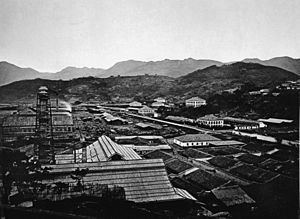Traditional Chinese 福州造船廠 Traditional Chinese 馬尾造船廠 | Simplified Chinese 福州造船厂 Hanyu Pinyin | |
 | ||
Wade–Giles Fu-chou Tsao-ch‘uan-ch‘ang | ||
Special edition 02 01 2016 the story of the foochow arsenal part 1
The Foochow Arsenal, also known as the Fuzhou or Mawei Arsenal, was one of several shipyards in Qing China as part of the Self-Strengthening Movement. The shipyard was constructed under orders from Li Hongzhang and Zuo Zongtang and was situated in Mamoi (now Mawei), a port town within the jurisdiction of Fuzhou (then romanized as "Foochow"), which is several miles up the Min River.
Contents
- Special edition 02 01 2016 the story of the foochow arsenal part 1
- Special edition 02 05 2016 the story of the foochow arsenal part 5
- History
- References
Special edition 02 05 2016 the story of the foochow arsenal part 5
History
Planning for the shipyard, the Fuzhou Naval College (t 船政學堂, s 船政学堂, p Chuánzhèng Xuétáng, w Ch‘uan-cheng Hsüeh-t‘ang), and other facilities began in 1866. Construction began in 1867. Two French Naval officers, Prosper Giquel and Paul d'Aiguebelle, both on leave from the French Imperial Navy, were contracted to recruit a staff of about forty European engineers and mechanics, and to oversee the construction of a metal-working forge, the creation of a Western-style naval dockyard, the construction of eleven transports and five gunboats, and the establishment of schools for training in navigation and marine engineering—all within a five-year period. Chinese authorities provided the materials and labour; The number of labourers rose from an initial figure of 1600 to more than 2000 by 1872. the operating cost over the five years was estimated at 3 million taels, and the cost of maintenance of the ships produced was partly funded by revenue from duties on the import of opium. The first ship produced at the Arsenal, the 150-horsepower Qing Forever (t 萬年清, s 万年清, p Wànnián Qīng, w Wan-nien Ch‘ing), was launched in June 1869.
The shipyard was almost entirely destroyed by French forces in 1884 during the Sino-French War of 1883-1885, in the battle of Fuzhou. A modern shipyard was later rebuilt on the site.
